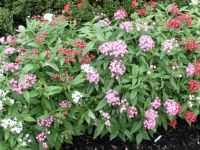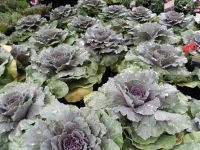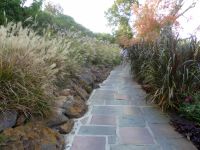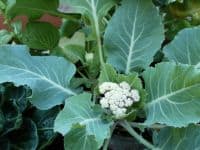End of Season Blooms

Although the season has come and it is officially Autumn, our local weather says it is still summer. Many flowering warm season plants continue to bloom and highlight our gardens, such as Angel’s trumpet, pentas, begonia, roses & vinca to name a few.
Cool-Season Flowers
We can begin to plant cool season flowers & plants this month and next month but wait until the night time temperatures are consistently cool in the 60’s preferable 50’s. Some of our favorite plants are, petunias, chrysanthemums, pansies, viola, dianthus, snapdragon, alyssum, sweet peas, calendulas, forget-me-not, lobelia, cyclamen, primrose, nicotiana, ornamental cabbage & kale.
Preparing for a fall garden

It is essential to remove all weeds, especially perennial grasses from the garden. If you simply till the grasses in and then irrigate, you’ll end up with a relatively nice lawn. Use herbicides if you must; till and pull out all vegetation. Till or work the top 6-8 inches of soil.
Plan for irrigation or make sure a hose will reach the garden. Irrigation is a must.
Purchase fresh seed or transplants. Pick transplants that have roots reaching the edge of the container. You should easily be able to pull the plant out of the container with the soil intact. You don’t want the roots wrapping around in circles. This indicates that the plant has been left in the container too long and will not do as well once planted in the garden.
Bulbs to Plant for Spring Flowering
Spring flowering bulbs are those that bloom in our climate between February and April. These bulbs are planted October, November and early December.
Purchase the highest quality bulbs your budget will allow. Overall, the price you pay for color from bulbs is higher than for longer flowering cool-season bedding plants like pansies and dianthus. So, spring bulbs are typically used more for embellishment than for providing the primary floral display (for that, it’s best to rely on bedding plants, such as pansies, violas, snapdragons and dianthus).
Good drainage, part to full sun and moderately fertile soil are all that are needed for bulbs to do well. About six hours of direct sun a day will produce the best plants and is especially important for those bulbs that you expect to re-bloom in future years.
A good rule is to plant bulbs at a depth equal to twice their height – generally, about 1 inch deep for small bulbs and 5 inches deep for larger bulbs. Once the bulbs are planted, you can plant over them with low-growing cool-season annuals such as alyssum, violas or pansies. Be careful not to disturb the bulbs. The annuals cover the bare soil and provide color before, during and after the bulbs bloom.
Tulips and hyacinths will perform much better if they are refrigerated at least six weeks in the vegetable bin of your refrigerator prior to planting (storing longer than six weeks is fine). Store them in paper or net bags (well-labeled) away from apples and other fruit. Plant them in late December or early January when the soil has had a chance to get cold.
Although many commonly available spring flowering bulbs don’t bloom well after their first spring, several spring bulbs tend to be reliably long-lived even in South Louisiana. One group includes the narcissus cultivars, such as paperwhites, Chinese sacred lily, Soleil d’Or, Grand Primo, Cheerfulness, jonquils, Sweetness, Trevethian, Peeping Tom, February Gold, Thalia, Ice Wings and Petrel. Another group includes larger flowered daffodil cultivars, such as Ice Follies, Unsurpass-able, Carlton and Fortune. Other re-blooming bulbs include snowflake (Leucojum aestivum), some flowering onions (Allium neapolitanum, A. drummondii), ground orchid (Bletilla striata), amaryllis (Hippeastrum species and hybrids), Spanish bluebells (Hyacinthoides hispanica), spring star flower (Ipheion uniflorum), Dutch iris (Iris x hollandica) and Easter lily (Lilium longiflorum).
Dig up caladiums when many of the leaves have fallen over and the plants look tired. Don’t wait for the foliage to completely die and disappear. Dry the tubers with the foliage attached for a week or two, remove the papery tan foliage and store the tubers indoors over the winter in containers that breathe.

Preparing Flowerbeds
To replant your beds, first remove the old plants and put them in your compost pile. But try to avoid putting any weeds that have set seeds in the compost. You also could spray the weeds with glyphosate herbicide (various brands) to kill them before removing them. This would be especially recommended if you are dealing with tough weeds, such as Bermuda grass, torpedograss or dollarweed.
Next, spread a 1-inch to 2-inch layer of organic matter – such as compost, bagged or aged manure, landscape soil conditioner, grass clippings or peat moss – over the bed. Sprinkle a light application of any general-purpose fertilizer (following label directions) over the organic matter and then thoroughly incorporate everything into the soil. Rake it smooth, and the bed is ready to plant.
When planting late in the growing season, choose well-established plants in 4-inch or larger pots. Make sure the plants you purchase are healthy and vigorous and have been properly cared for. Avoid plants that look wilted or leggy, have poor color or show signs of insect or disease problems.

Ornamental Grasses
A group of perennial plants that should be considered for the landscape are ornamental grasses. Most grow in self-contained clumps. Ornamental grasses have diverse forms, colors, textures and sizes. Most are not particular about soil conditions. Nearly any well-drained garden soil is acceptable.
Some grasses for Autumn color include, Calamagrostis acutiflora stricta,
C. arundinacea brachytricha, Festuca cinerea “Solling’, Luzula purpurea, Miscanthus sinensis purpurascens, M.s. ‘Herbstfeuer’, M.s. ‘Gracillimus’, Molinia caerulea ssp.arundinacea & cultivars, Pennisetum alopecuroides viridescens, Panicum virgatum ‘Rehbraun’, P.v.’Haense Herms’, Spodiopogon sibiricus.
Trees & Shrubs for Autumn & Winter Color
Many trees and shrubs in your landscape will provide significant color in fall and winter year after year.
Late November/early December is when the leaves of some deciduous trees turn various colors as they get ready to drop. A few of the trees that reliably color up well in Louisiana include: ginkgo (Ginkgo biloba); sweet gum (Liquidambar styraciflua); Chinese pistachio (Pistachia chinensis); Callery pears (Pyrus calleryana); black gum (Nyssa sylvatica); crape myrtle (Lagerstroemia indica); dogwood (Cornus florida); Japanese maple (Acer palmatum); southern sugar maple (Acer barbatum); and some oaks. Generally, the farther south you live in Louisiana, the less fall color you will see.
Plants also provide color in fall and fruit in winter. Hollies, with their brilliant red berries, are notable in this regard. Excellent choices for Louisiana include the popular Savannah holly and Foster’s holly (Ilex x attenuata Savannah and Fosteri), both small trees. Beautiful native hollies include the yaupon holly (Ilex vomitoria), deciduous holly (Ilex decidua) and winterberry (Ilex verticillata). A great thing about holly berries is that they are excellent wildlife food for birds. Shrubby hollies also produce colorful berries. Varieties include Burford, Dwarf Burford, Nellie R. Stevens, Needlepoint, Dixie Star, Dixie Flame and many others.
For flowers in the fall and early winter, choose sasanquas (Camellia sasanqua). Sasanquas are one of those indispensable shrubs for Louisiana landscapes and bloom from October well into December. Camellias (Camellia japonica) will begin to bloom in November and continue through the winter until spring.
Roses are also important for fall and early winter color. Everblooming roses put on a wonderful show in October and November and will often continue to bloom through mid December and beyond, weather permitting.
Generally not known for their fall blooming, azaleas that bloom during seasons other than spring are becoming more popular. The Encore azalea series is well known for fall bloom. Some of the Robin Hill azaleas such as Watchet and Conversation Piece and the popular Glen Dale cultivar called Fashion should be considered for fall landscapes.
Vegetables & Herbs

Vegetables to plant now, cabbage, broccoli (transplants), mustard,* turnips, collards, kale, shallots, radishes, beets, spinach,* leaf lettuce, Chinese cabbage,* celery, onions, Swiss chard, garlic, carrots endive,* Brussels sprouts (transplants), cauliflower (transplants), green peas, snow peas, edible podded peas, kohlrabi, parsley and rutabaga.
*Plant first part of the month.
Herbs to plant now include parsley, sage, thyme, dill, cilantro, rosemary, oregano, borage, fennel, nasturtium, French tarragon, chives, mint and catnip.
Autumn Care for Lawns
Louisiana usually stays warm well into the fall, and lawns continue to grow until nighttime temperatures dip into the 50s. Mow and water your lawn as needed to keep lawns healthy. Fertilizing warm-season grasses during the fall with high nitrogen (summer-type) fertilizers or winterizers containing nitrogen are not recommended for southern lawns. Stimulating fall growth of our warm-season turf with nitrogen leads to increased brown patch disease and winter kill.
If you need extra color on home lawns this fall, apply foliar iron spray or spreadable granules. The only other fertilizer that can be applied in the fall is muriate of potash. Muriate of potash (0-0-60) may be applied in September or October to provide increased disease and cold tolerance. Most garden centers and feed stores have this form of potash. Get a soil test before applying potash to your soil. There is no advantage to applying excessive amounts.
submitted by Karen Blackburn
